
|   |

|   |
The 14th Guru Debaprasad Award Festival at Bhubaneswar - Nita Vidyarthi e-mail: drnitav@rediffmail.com Photos courtesy: Tridhara April 13, 2021 The 14th annual Guru Debaprasad Award Festival 2020, in fond memory of the Odissi legend was held in the Rabindra Mandap with the usual three-day grandeur of music and dance. The grand annual celebration could not be held at its scheduled time last year due to the pandemic and had to be carried over to this year. Organised by Tridhara, the institution established by the Guru himself and now spearheaded by its director Guru Gajendra Panda, his distinguished disciple and the main custodian of his gharana, the awards of the year 2020 went to Aruna Mohanty (Odissi dance), Bhubaneswar, Ghanakanta Bora (Sattriya nritya), Assam, and Gopika Varma (Mohiniattam), Chennai. 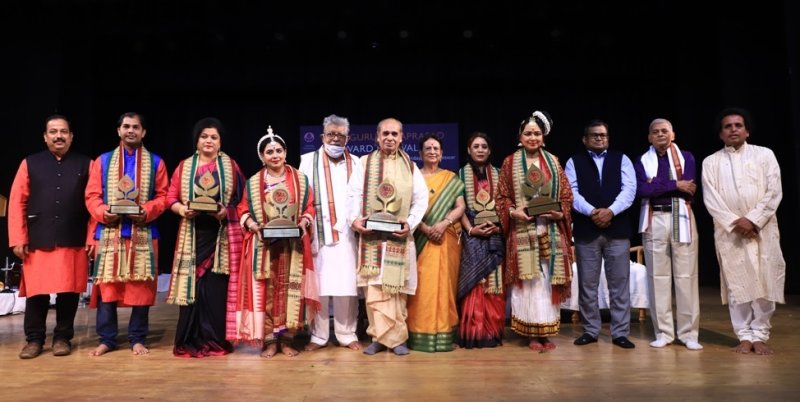 Awardees The recipients of Guru Debaprasad Prativa Award 2020 for promising young talents were Dr. Manoj Kumar Behera (Balasore), Prativa Panda (Bhubaneswar), Binod Chandra Sahu (Khandhamal) and Palomi Mondal (Kolkata). The Lifetime Achievement Award was presented to Anup Jalota on the opening evening after inauguration. This was followed by an imaginatively composed compact Odissi dance drama entitled 'Sankhipta Ramayan' by the principal dancers of Tridhara, based on the epic Ramayan choreographed by Guru Gajendra Panda with immense attention to the aesthetics of the elements of the dance form. It is called 'Sankhipta Ramayan' (concise Ramayana) because the presentation begins with a single sloka - thus called an "Eka Sloki Ramayana" (Ramayana comprising of one sloka only). "Adyau Ramam Tapobanadi Gamanam Hatwa Mrugi Kanchanam. Baidehi Haranam Jatayu Maranam Sugriba Sambhasanam. Bali Nigrahanam Samudra Taranam Lankapuri Dahanam. Sese Ravan Kumbhakaranadi Hananam. Etasya Ramayanam." (So ends the Ramayana). The production opens with King Dasarath entering the court with his ministers followed by the court dancers entertaining the gathering with a group item set to Odissi music. At this point kulaguru Vashisht enters. King Dasarath welcomes him with obeisance saying "Ajo kede bhagiyo moro, lovilee shanidhyo tobo hey rushi shekahro" (How lucky I am today to have your august presence, O Great Sage!). He seeks the permission of the Guru to declare Ram as his successor and make him the King after he retires and goes to "Vanaprastha." After the Guru's consent and declaration, the people of Ayodhya celebrate their delight through a vibrant dance and song sequence "Nacho nacho re bajayi baja! Ame Ramo rajya praja, amo rama hebe Raja" (dance and play the music, oh the subjects of Ram, our Ram would now be our King)! 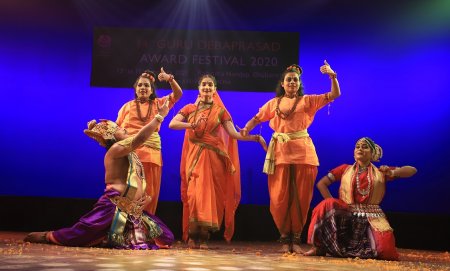
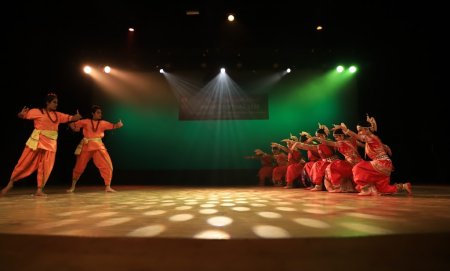
The story takes the usual course with the abduction of Sita, Lanka Dahan (Burning of Lanka), killing of Ravana, Sita Udharan (rescue of Sita) and return of Ram, Sita and Lakshman with their army to Ayodhya, celebrating victory of good over evil. Music by Pandit Haramohan Kunthia enhanced the appeal and the dramatic vitality of the choreography by Guru Gajendra Panda and kept alive the classical refinement of the fluid grace and mathematical precision of the dancers wholeheartedly with the storyline of the epic. The apposite script was by Kabi Kashinath Nayak. Gajendra Panda had put in a lot of attention to the emphasis and the selection of the episodes from Tulsidas Ramayan and intertwined it with the style of Guru Debaprasad Das, which the dancers, chosen for the individual characters on the basis of their training, demonstrated with kinetic perfection and dramatic skills. The well-planned one-hour production had some memorable moments and good song and dance sequences between Ram and Sita like the golden deer episode) "Dekha dekha hai Raghumani ki sundara yehi hema harini…..minati aahe Raghupati diya ye bichitra mruga ku ani", Jatayu informing Ram about the abduction of Sita set to "Hey Raghunath suna mora vani", the indispensable and famous Ravana Kruta Shiva Tandava "Jatakatahashambrahamahm Brhamamnilampa Nirjhari…" by Prabhutosh Panda, a strong, virile dancer, brilliant as Ravana. Arya Nanda as the jealous, conceited Kaikeyi and tyrant King Bali, G. Nageswari as Ram, Tejashree Jena as Jatayu and also as Sugriva and Rithika Banerjee as the scheming Manthara and Hanuman proved their training in the richness and variety of expressions even while doubling up in different roles - something that is missed out in most dancers. Twelve more dancers of the institution supported in the group items. The return to Ayodhya with Sita after fourteen years and victory of Lanka was a captivating moment of triumph, concluding the presentation with the closing sloka: "Ramaya Ramachandraya Ramabbhadraya Vedase Raghunathaya Nathaya Sitayapataye Namaha". 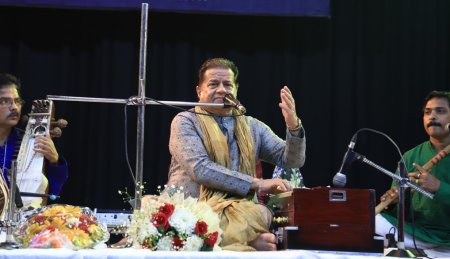 Anup Jalota It is always a pleasure to hear Bhajan Samrat Anup Jalota rendering popular numbers like "Aisi lagi lagan, Main nahi makhan khayo, Rang de chunariya, Jag me sundar hai do naam," and many more again and again and he closed the evening soulfully with such numbers. Renowned accompanists Pandit Prosenjit Poddar on the tabla, Prof Jawahar Mishra on the flute, Pandit Ramlal Mishra on the sarangi, Kousik Mukherjee on keyboard and Arindam Ghosh on guitar added glitter to the recital. The 2nd evening opened with a fine Odissi presentation 'Bighna Binashana' by the performing group of Kala Vikash Kendra, Cuttack, based on Lord Ganesha. Scripted by Pandit Nityananda Mishra set to Dr. Prafulla Kar's music, with rhythm composed by Guru Dhaneswar Swain, the dancers were able to synchronise their movements with impeccable togetherness following the choreography of Guru Gajendra Kumar Panda. 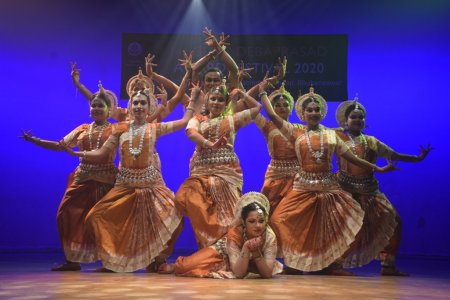 Bighna Binashana 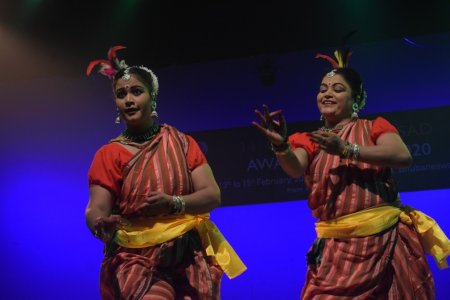 Prativa Panda and Aditi Panda This was followed by a vibrant and enjoyable Chhau dance (duet) by Guru Prativa Panda and Aditi Panda set to traditional Odia music 'Rasalata'. They displayed good body control in the items demanding strong, sharp movements which often highlighted an amalgamation of traditional and folk dances of Odisha with glimpses of the Debaprasad style. The colourful costumes and happy numbers made the performance a viewing pleasure. A welcome addition since 2019, was the inclusion of Odissi music in the Award Festival and began with a tabla recital by Subhashish Das. Stalwarts Guru Dr. Gopal Chandra Panda and Sangeeta Panda and Pandit Dr. Damodar Hota made the evening memorable with an offering of emotionally appealing Odissi songs embellished by different ragas, punctuated with indigenous musical and rhythmic patterns. The audience missed out on the mellifluous singing of the octogenarian Dr. Syamamani Pattanayak because of her indisposition. 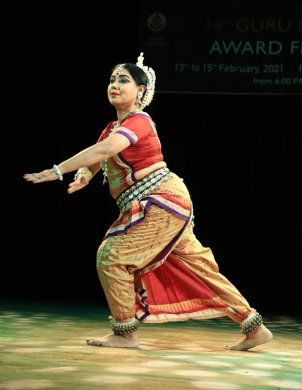 Aruna Mohanty After the Award ceremony on the third evening came two captivating solo dance recitals by this year's award winning dancers. The distinguished Odissi dancer Guru Aruna Mohanty, known for her soulful and distinctive abhinaya has created her own identity not just for her excellence in execution of the undiluted quality of the grammar of her dance but for her in-depth visualisation and complete understanding of the nuances of the theme and needs of the item making her offering not a spectacle but an experience proving each time what a great virtuoso she is. Hence 'Bishwaprakasha' (Illuminating the Universe) conceived and scripted by Kedar Misra based on the poem by the blind tribal poet Bhimo Bhui, believing on "Nirakara Brahma" discovered spirituality through the finest elements of execution of the acclaimed dancer. Set to music by Ramhari Das and Gopal Chandra Panda with Aruna Mohanty's choreography and rhythm by Dhaneswar Swain and Bijoy Kumar Barik, the dancer created some intense moments of complete surrender which heightened to a definite controlled tension of stunning facial expression at the end. 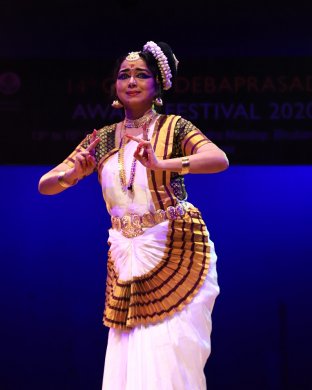 Gopika Varma Consummate Mohiniattam dancer Gopika Varma's visual imagery of the famous Maharaja Swati Tirunal Bhajan "Bisheswar darshan kar chal man tum Kashi" choreographed by her was a succession of artistic argument enhanced by choreographic technique, fine dancing, controlled, delicate lower torso movements and tender balanced gyrations, so characteristic of the dance style. It was sheer optical beauty to watch the dignified dancer's changing facial expressions from the Pallavi "Bisheswar chal man.." where Lord Bisheswar manages everything to the two major sancharis, one the jananam-maranam cycle and the other river "Ganga's ahamkaar nigraham". In the charanam "Padmanabha Kamalanaya Trinayana Shambhumaheswara.." that the two conflicting beliefs of Vaishnavites and Shaivites are one and the same were etched out with sensitivity. Set to ragam Sindhubhairavi and talam roopakam, Gopika's performance once again established that she is a dancer of high calibre. Bayan acharya Ghanakanta Bora did not perform but offered his sincere thanks to all the organizers for felicitating him with an award in honour of such a great master. He recalled the contributions of the great master towards Odisha and Indian dance scenario for that matter. He also spoke about the historical connections of the land of Assam and Odisha and recited the few lines of Oresa Barnan as penned by the great saint-poet Srimanta Sankaradeva in his poetic works of Kirtan Ghosha and remembered the contributions of all the great practitioners of the Sattras. 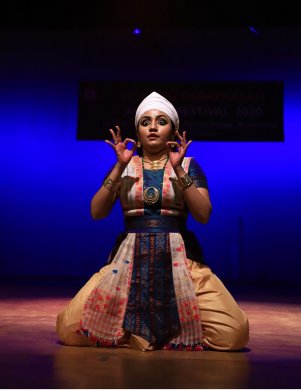 Anwesa Mahanta In honour of her adhyapak Ghanakanta Bora, his senior disciple Dr. Anwesa Mahanta gave a short Sattriya dance performance to close the Award Festival. A well- known and established dancer, she began with a pure dance sequence from Behar Nach set to a Kirtan, followed by "Nrisimha Lila" based on one of the incarnations of Lord Vishnu and the popular story of King Hiranyakashipu and his son Bhakta Prahlad. Based on the episode of Prahlada Charitra by Srimanta Sankaradeva, the piece was set to Kirtana rendition and Ektal. 34th Sradhanjali Samaroha, Bhubaneswar In remembrance of Guru Debaprasad Das, Tridhara presented its annual festival of dance, Sradhanjali Samaroha on 16th March this year instead of his death anniversary on July 16th, due to the pandemic, at Rabindra Mandap, Bhubaneswar. This year there were about 50 groups from different parts of the state and outside comprising of Gurus, seniors and juniors all belonging to the Debaprasad Gharana. Held from 9am to 9pm it began, like previous years, by garlanding of the Guru's statue at the Utkal Sangeet Mahavidyalaya premises and returning to the auditorium in procession. The festival this year saw guest artists from Jayantika, Guru Mayadhar Raut School of Odissi Dance, New Delhi. The program was compered by Dr. Srinibas Ghatuary. 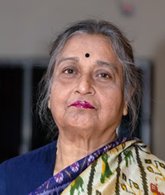 Dr. Nita Vidyarthi is a veteran critic of performing arts and writes on dance, music and theatre in leading publications. |